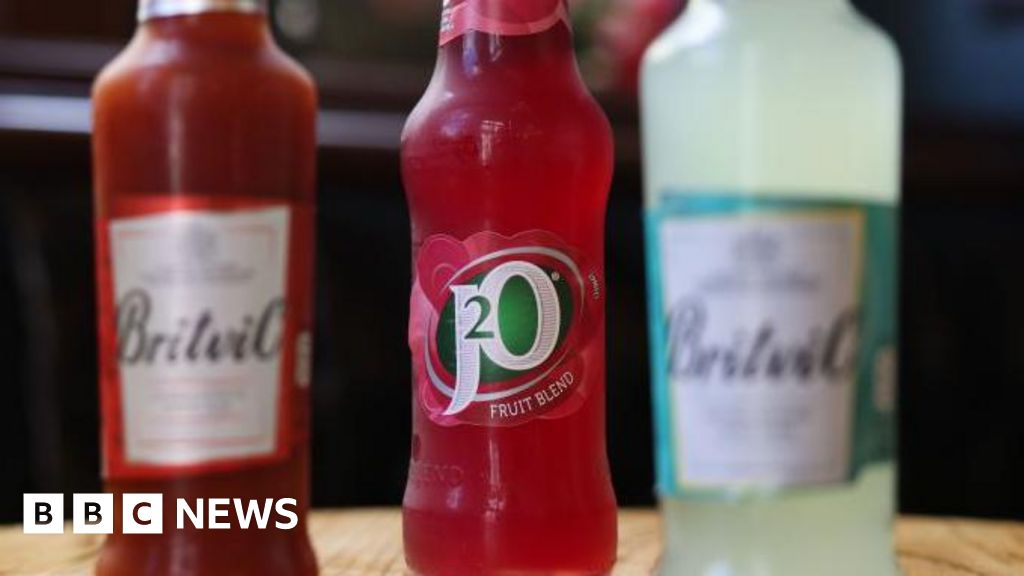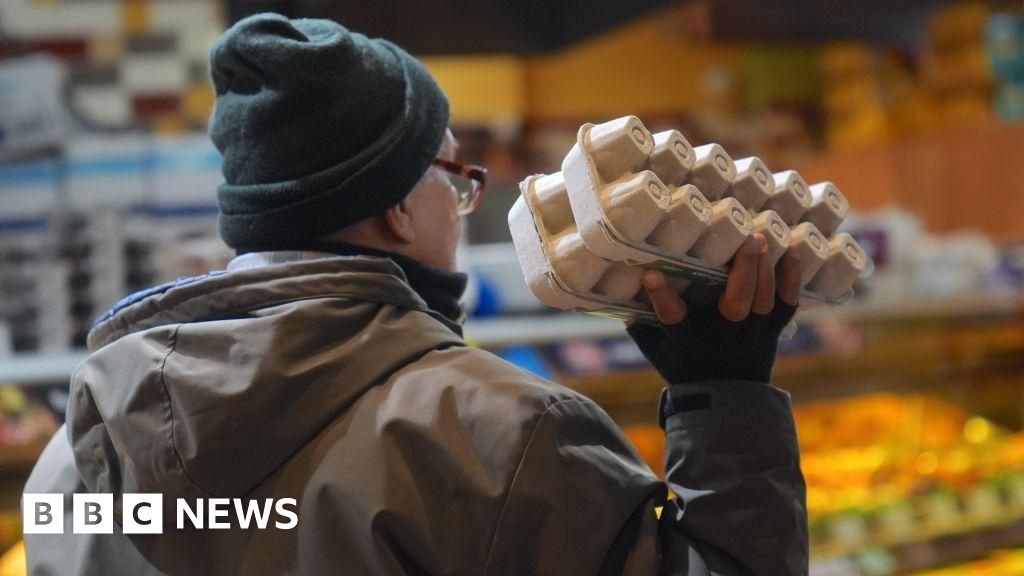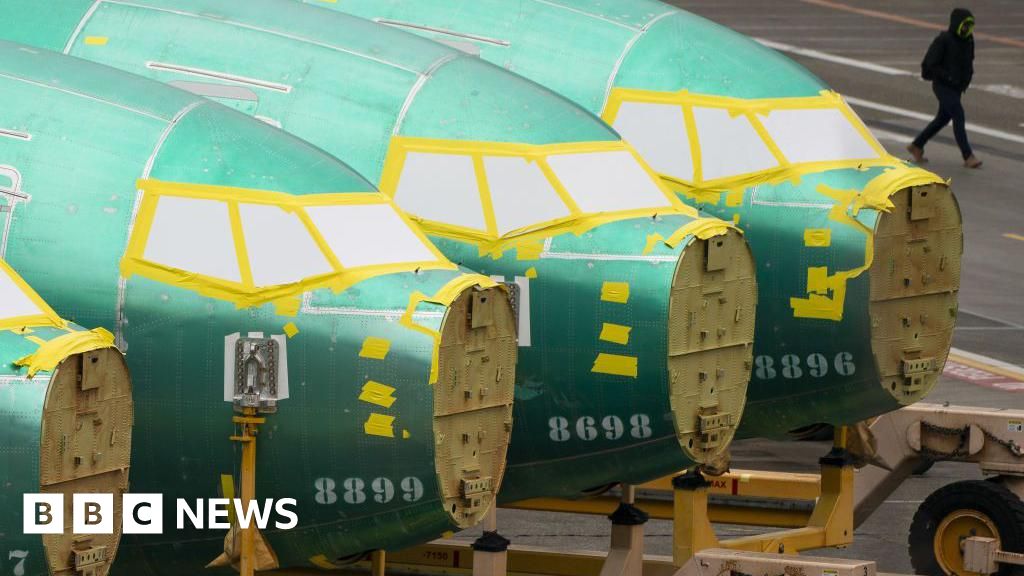
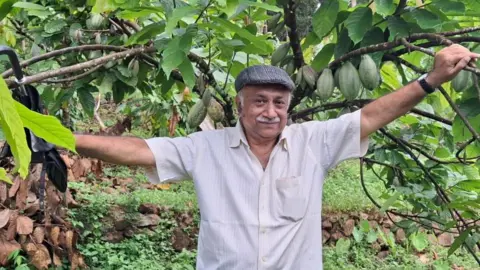 George Matthew
George Matthew
George Matthew moved into cocoa production to keep his farm going
If it hadn't been for the squirrels, George Matthew's attempt to become a cocoa bean producer might have failed.
His farming career began in the 1970s when he inherited a rubber plantation in the the southern Indian state of Kerala , which he managed alongside his career as a doctor.
It was a bad time to inherit a rubber plantation, falling rubber prices meant it kept losing money. So, 10 years ago Dr Matthew decided to experiment with cocoa trees, hoping they would generate some funds to support the rest of the farm.
He bought some saplings and planted them. It didn't go well.
"It was not that successful - most of the saplings died," he says.
Squirrels appeared to be making the situation worse by grabbing cocoa bean pods and eating them.
But those raids had an unexpected benefit - cocoa seeds were spread all over the farm.
"All the scattered seeds soon grew in to plants and they were much healthier and stronger than the saplings I had planted," says Dr Matthew.
"The trick was in sowing the seeds," he realised.
Today Mr Matthews has 6,000 cocoa trees on his 50 acres of land.
"I think it was the best decision I have made," he says.

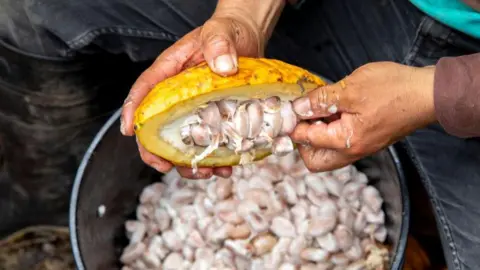 Getty Images
Getty Images
Cocoa beans have to be removed from their pods and processsed
Despite having several regions with weather conditions suitable for cocoa trees, India only accounts for 1% of the world's cocoa bean production.
Global production is currently dominated by West Africa, where Côte d'Ivoire and Ghana between them produce more than half of the world's annual output.
Indian growers can only supply a quarter of the beans needed by Indian makers of chocolate and other confectionary.
"The challenge is that it is grown in very fragmented small holdings, so it does not get the kind of attention cocoa should get," says Renny Jacob, chairman of India Cocoa, a private company that has been growing and processing cocoa beans for more than 30 years.
In particular he says that Indian farmers are poor at handling beans after they have been harvested. Once removed from their pods, beans go through a fermentation process at the farm, which can make a huge difference to their flavour.
"Cocoa fermentation is a critical process in the production of chocolate, transforming raw cocoa beans into a form suitable for chocolate making," says Sarin Partrick, chief executive of India Cocoa.
"This complex process involves several stages and the activity of various micro-organisms, which help develop the beans' flavour, aroma, and colour," he says.

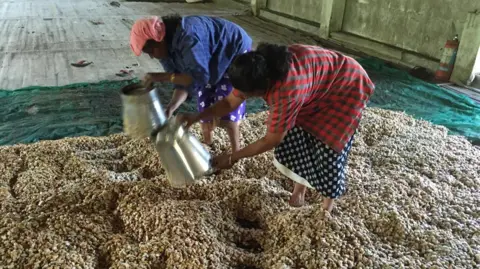 Cocoa India
Cocoa India
Fermenting cocoa beans develops their flavour, aroma and colour
To raise the quantity and quality of cocoa bean production, the government has introduced several initiatives.
It is investing in schemes to develop hybrid cocoa plants, that are more productive than existing varieties.
In addition there are schemes to train farmers on the latest techniques for growing and processing beans.
“There is a vast opportunity for Indian farmers to enter into cocoa cultivation and avail the benefits," says Dr Femina, who works in the government department tasked with developing cocoa production.
Business is also investing in new cocoa tree vareities.
Dr Minimol J.S., is the head of cocoa research at Kerala Agriculture University and is working with Cadbury to develop hybrid cocoa trees.
In the project's orchard existing high-performing varieties are cross-bred with exotic species.
So far the programme has come up with 15 new varieties.
"These are India's first hybrid, disease-resistant seeds," she says.
"The seeds are drought tolerant varieties, and have withstood temperatures of even 40C, which is usually not possible," she adds.
The hybrids are also much more productive than traditional varieties.
"The global average production is 0.25 kilogram per year per tree.
"In Kerala, we get 2.5 kilograms per year per tree. In Andhra and Telangana, we are even getting a yield of four or five kilograms per tree per year," she says.

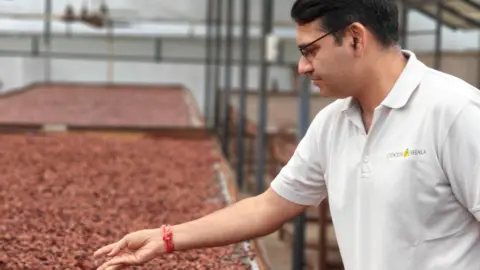 Kocoatrait
Kocoatrait
Nitin Chordia runs a school for cocoa farmers
India's production of cocoa beans has risen significantly. This year it hit 110,000 tonnes, up 40% from 2015. But it's still not enough to meet demand from local chocolate and confectionary makers.
India's Cocoa Board estimates the demand from industry is rising at 15% per year.
Founded in 2019, Kocoatrait is one of a new generation of Indian chocolate makers.
Based in the east coast city of Chennai, the company only uses Indian cocoa beans.
One reason for that is that locally sourced beans have a much smaller carbon footprint than beans that have been shipped from another continent.
In addition, says Kocoatrait founder Nitin Chordia, Indian beans are cheaper than imports and have a distinctive flavour.
Mr Chordia also runs an agricultural school, where farmers are shown the latest innovations in fermenting and drying beans.
"We are constantly focussing on improving the post-harvest practices for cocoa farmers in India," he says.
He adds that Indian farmers need to be producing higher quality beans.
"We are not able to compete with international players in the bulk cocoa bean segment,” he says.
While there has been improvement, Indian producers have some way to go.
"Over the last decade, in the fine-flavour cocoa bean segment, India has started to get noticed... but it will be several years before all Indian fine flavour cocoa beans reach a stage of large-scale international recognition."
Back in Kerala, Dr Matthew reflects on his decade as a cocoa farmer.
"It's a tricky plant," he says. "Last year I had no yield. So no farmer can depend solely on cocoa - one has to plant other trees along with it."
Despite the challenges, he's optimistic. "The future is bright, with huge demand."
"I have been approached by a multi-national company to sell my production to them, so I will be making a good profit.”
More Technology of Business

 1 month ago
10
1 month ago
10
